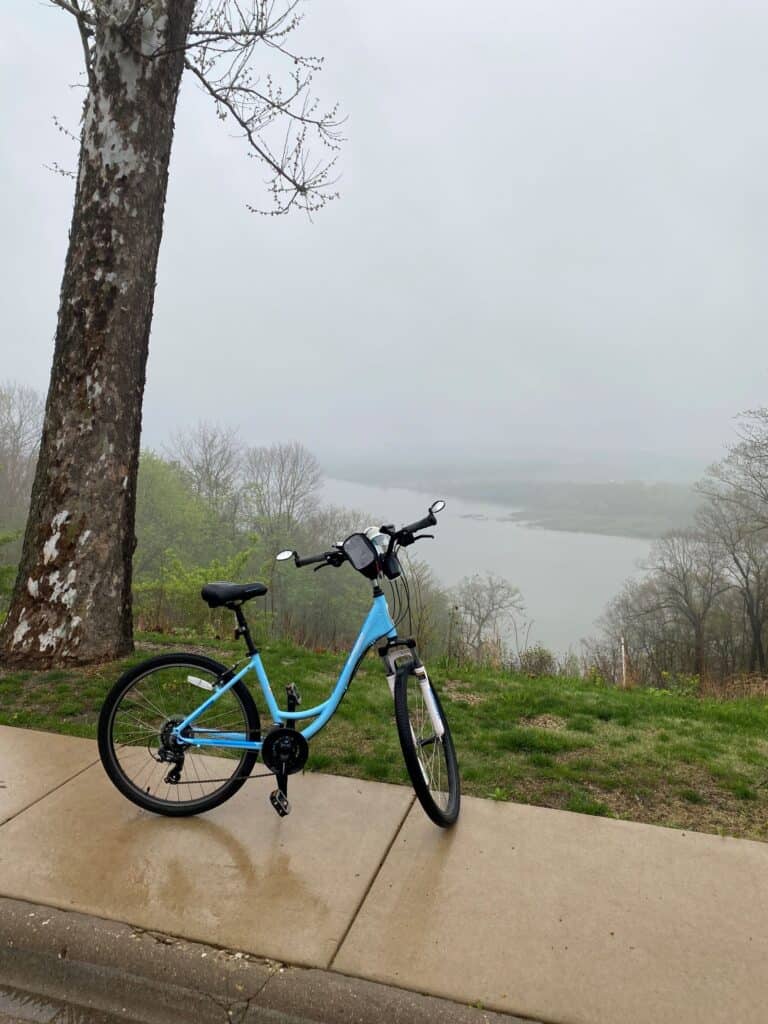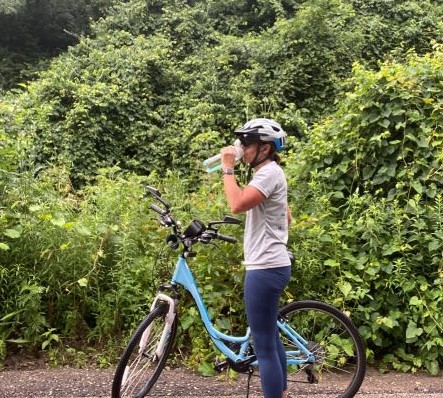How to Bicycle Uphill: 15 Tips for New Riders
Why is bicycling uphill so hard?!
Are you tired of avoiding that daunting hill on your route? Have you been dreading the uphill struggle every time you plan your rides?
Whether it’s a short, steep incline or a gradual uphill battle, let’s face it – biking uphill can be tough!
I remember the first time I took on a hill. I was a little nervous for sure. I had no idea how to go uphill on a bike – I was just a beginner.
My legs were trembling, and my bike was all over the place.
But guess what? After a few minutes, I started enjoying the challenge. It felt amazing to push myself and conquer that hill.
Reaching the top was an incredible feeling of accomplishment. I’m always so proud of myself when I make it.
So, how can you conquer your nemesis and master that uphill climb as a beginner?
It’s a combination of strength, endurance, and skill. Don’t worry, I’ll show you how to tackle those hills like a pro.
Are you ready to take on the challenge? Let’s do this!
Tips and Tricks for Bicycling Uphill
Are you someone who says “I hate biking uphill”?
Well join the club! As beginners we are all a little intimidated by hills.
But don’t worry with these tips and tricks you will learn how to bicycle uphill as a beginner!
1. Preparing for The Climb
A little prep could be the thing that gets you up that hill and leaves you wanting to do it again – or maybe it will make you want to try an even bigger hill next time.
Who knows? The sky is the limit!
Here are a few ways to prepare for the ride and the climb.
Make Sure You’re Comfortable
If you’re thinking about advancing to climbing hills, then you’ve probably been cycling for a little while.
I’m sure that by this point you have worked on getting your bike to fit you just right and you’re comfortable riding.
Things like – is your seat in the right position? Are your handlebars where you need them?
If you’re not comfortable on your bike – then start here.
Map Out Your Route
Be sure to know what route to take.
This way, you can avoid the really big hills until you have mastered the smaller ones. It can also help to limit the number of inclines until you are ready.
Pay Attention to The Weather
If you are thinking about tackling that big climb, but the day is rainy or especially windy, you may want to reconsider.
Wet roads and heavy wind may make climbing that hill a lot harder than it needs to be.
Failing to reach your goal due to weather may leave you not wanting to try again. So be sure to take this into account.
Don’t waste the day though, go out and do some smaller inclines to see how you do and what you need to work on.
There is no shame in that. Then you will be ready to do the big one on a different day.
READ MORE: Bicycling In The Rain: Is It Safe For New Riders? | Simply Aging Healthy

Fuel For Your Ride
Improve your ride with a healthier diet! The food you eat plays a crucial role in your cycling performance.
Don’t overlook the impact of your daily meals on your energy levels and overall ride experience.
Before you hit the road, take a moment to assess your diet. Choosing more nutritious options will empower you to conquer any uphill battle.
On the flip side, a poor diet filled with unhealthy fats and carbs can lead to a crash during your ride.
Additionally, your daily food choices play a huge role in weight control.
When it comes to climbing hills, your power-to-weight ratio is super important. The heavier you are, the more effort it takes to pedal uphill.
However, don’t misunderstand and think starving yourself is the solution.
Without proper fuel from food, you won’t have the strength that you need to get up there.
Instead, focus on eating balanced and healthy meals to maintain a manageable weight.
Trust me, those challenging climbs will become much more achievable.
READ MORE: Beginner Bike Rider Over 60: How To Fuel For A Ride? | Simply Aging Healthy

Hydrate
Prepare for your big ride by starting to drink enough water the day before. Aim for 2 liters to stay hydrated and ready.
On the day of your ride, continue staying hydrated. Drink water even before you hop on your bike.
During your ride, remember to keep drinking and keep water on hand.
Don’t forget to bring your water bottle with you. It will come in handy when you reach the top of that difficult climb!
You don’t want to dehydrate on your ride. If you do, climbing a challenging hill could take you out of the game.
READ MORE: Why Water Is Important For Older Adults: Benefits And Tips | Simply Aging Healthy

2. Practice, Practice, Practice
Make your first climb an easy one.
Practice that hill over and over again. After you are able to do it once on your ride then try doing it twice the next ride. Add onto the number of times you do it every time you go out.
Once you master it, go to a bigger, steeper hill or a long gradual incline and do it again once. The next time you go out, do it twice and then three times. Keep building until you are ready for a bigger hill.
As with everything we do, we have to practice to become better. It will also make you stronger for the bigger climbs.
3. Don’t Freak Out
Do you find yourself immediately panicking when you see a hill?
When going into any incline, steep or gradual confidence is everything.
If you panic, you start to breathe harder, and then your heart rate starts to increase. This causes you to expend way more energy than you need to.
So, the best thing that you can do is just relax and push through.
Who doesn’t remember The Little Engine That Could, “I think I can, I Think I can”? Every time I get to a hill, I find myself starting to say that phrase.
The only difference is I change the words from “I think I can” to “I Know I can”. Hey whatever it takes right?
This helps me to get my breathing in check and stops me from pushing harder than I needed.
Don’t fill your mind with doubts. If you do you are sure to set yourself up to fail.
4. Relax
This is so important. If you’re tense and have a death grip on your handlebars or if you are putting too much stress on your back, climbing will be harder.
It will also be a horrible experience.
Instead, place your hands lightly on the handlebars and move towards the center. Your arms should not be locked out straight ahead. Instead, they should be relaxed and hanging down by your sides.
Don’t slam down on your pedals, and this takes a lot of energy. Try smooth, easy rotations instead.
This could be the difference between a horrible experience vs an awesome one. You will want to keep tackling the next big hill.

5. Just Breath
Take a moment to notice your breath. Are you breathing too quickly or not at all?
It may seem simple, but when faced with a challenge, we often forget to breathe properly. This can lead to overexertion and make it difficult to conquer that uphill battle.
Trust me, I experienced this every time I approached a hill.
However, through practice and time, I discovered the importance of relaxation and taking slow, deep breaths.
By doing this, you ensure that your hardworking muscles receive the oxygen they need to generate that energy for your climb.
6. Use Momentum
If you want to save your legs and conquer hills with ease – it’s all about building up momentum.
Before reaching a hill, pedal a bit faster on flat ground to get that burst of speed. Then, downshift to a lighter gear as you tackle the incline.
If you’re on hilly terrain, momentum is extremely important.
When descending one hill, upshift and keep pedaling into the next one. As you approach the next incline, downshift again to maintain your momentum.
The key is to keep those legs moving. By continually pedaling, you’ll maintain the momentum you need to keep going.
So, if you lose all momentum going uphill what is the most important thing to remember? – shift into a lower gear and speed up to maintain momentum.
Don’t let hills slow you down – harness the power of momentum and conquer any route with confidence!
7. Proper Gear Selection for Climbing
Choosing the right gear for a climb is crucial, but there’s no one-size-fits-all solution. It’s all about trial and error to find what works best for you.
So, you will need to keep practicing and experimenting until you discover your winning formula!
Before starting your climb, make sure to downshift. Don’t try to be a hero by staying in a higher gear. This will only add unnecessary stress and strain to your ride.
Be smart and choose a lower gear to conquer those inclines with ease.
Avoid excessive shifting while climbing.
Constantly changing gears during the incline can put too much tension on your bike’s chain, leading to potential issues like difficulty shifting or even dropping the chain.
Imagine the hassle of fixing it midway! So, aim for a smooth ascent by minimizing unnecessary gear changes.
Remember, practice makes perfect!
Experiment with different gear combinations, prioritize your comfort and efficiency, and enjoy the rewarding experience of conquering challenging climbs.
8. Pedaling to Bicycle Uphill
Try not to pound your pedals.
Focus on moving your feet in smooth circles when pedaling. This will help to use more muscles and improve traction.
If the hill is more of a steep hill vs a slow incline – try riding your bike from side to side.
This will give you more of a flat surface vs steep incline.

9. Pace Yourself
Your pace will depend on factors like your weight, fitness level, and the incline.
It’s important to find a pace that works for you, so you’ll have enough energy to reach the top.
If you’re tackling a quick, steep hill, go in strong and push yourself a bit faster. But if you’re facing a gradual climb, take it easy and pace yourself.
A great way to gauge your pace is to see if you can still talk comfortably. If you can easily say simple sentences, you’re likely pacing yourself well. However, if you’re struggling to talk and catch your breath, it’s time to slow down or take a break.
Remember, it’s all about finding the right balance and listening to your body. You’ve got this!
10. To Sit or Stand?
What is the best approach for climbing – sitting or standing? The choice is yours!
When faced with gradual inclines, sitting is usually the way to go. It requires less energy, so you can keep going for longer. To maximize traction, downshift and lean back on your seat.
But what about steep climbs?
Well, sometimes you need to stand up and power through. Before you stand, make sure to upshift into a harder gear to add tension. This will give you the extra power and torque needed to conquer those steep sections.
Now, standing does have its risks. Your back wheel might slip. If that happens, simply shift your weight towards the back wheel to enhance traction.
Remember, while standing, try to keep your bike steady and avoid swaying from side to side. This will help prevent any unwanted falls.
Keep in mind that standing will tire you out faster than sitting. So, be wise about how often and for how long you choose to stand while climbing.
Find your climbing style and conquer those hills like a pro!
11. Lighter Load Makes the Climb Easier
A lighter rider and a stronger rider will do better than a heavier or weaker rider.
Why? Because pedaling up a hill becomes a breeze when you don’t carry unnecessary weight. It’s a fact – the heavier you and your bike are, the tougher the climb.
So, say goodbye to excess baggage and embrace efficiency. By minimizing unnecessary “stuff” on your bike, you’ll feel the difference in your uphill battles.
But don’t worry, we’re not asking you to sacrifice the essentials. Just be selective about what you pack.
12. Don’t Stop Pedaling at the Top
When you bicycle uphill, don’t stop pedaling before you get to the top. If you do you could lose your momentum.
This will probably stop you or at least slow you down and make the last part of the climb the worst part.
It’s best to just keep pedaling until you get to the descent.
13. No Shame in Walking
Unable to make it up the hill on your bike? No worries!
It’s important to listen to your body. Instead of pushing through and risking injury, simply get off the bike and walk.
There’s no shame in this – we all have different levels of fitness and ability.
The key is to set a goal for yourself – when you’re ready, give that hill another try. With time and practice, you’ll conquer it without any issues.
Don’t let frustration get the best of you, keep pushing forward and believe in yourself.
14. Be Patient and Have Fun
That’s what riding is all about – pure fun!
But hey, don’t forget to cut yourself some slack. We all need to practice to improve.
The key is to set goals for yourself and put in the effort to reach them.
Trust me, you’ll be blown away by how much you’ll progress in no time at all.
15. And Finally, If You Need a Break, Take One!
If you make it up the hill and you feel like you just can’t go any further than don’t!
To bicycle uphill takes a lot of energy.
Get off your bike, catch your breath and just enjoy the scenery or the company. When you feel like it hop back on your bike and continue on.
Your body and mind will both thank you for taking a well-deserved break.
Conclusion
Cycling uphill can be daunting, but with practice and the right technique it’s a breeze!
Taking time to prepare your bike for any incline ahead will prevent any complications and allow you to ride up the hill as smoothly as possible.
Furthermore, by following the tips outlined in this blog post you’ll be sure to make short work of any uphill terrain you come across.
As intimidating as it may seem, don’t forget that cycling uphill is great exercise and an incredible workout – makes those heart racing moments of climbing all the more worth it!
So, get out there and tackle that next hill with confidence.
You’ve got this!
